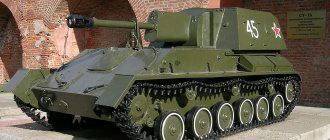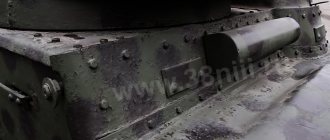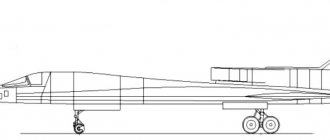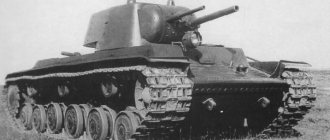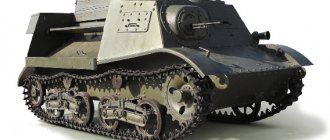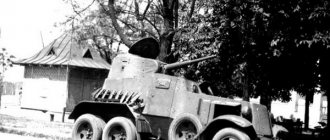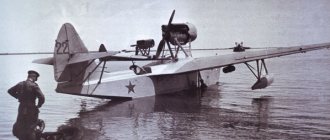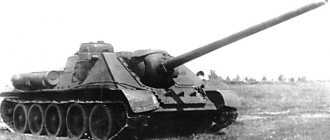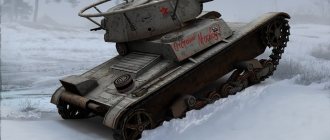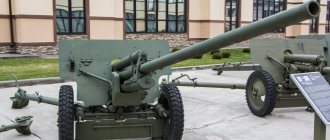Author: zaCCCPanec
09 May 2022 06:40
Community: Military
Tags: SU-122 stories about weapons history pages
4128
23
Continuing the topic of self-propelled guns of the 1942 model, and taking into account that this material will be published on the eve of Victory Day, we decided to talk about a machine that most of our readers know. About a vehicle that was developed in parallel with the self-propelled gun SG-122 that we have already described. About a car that was a direct competitor to the SG-122.
0
See all photos in the gallery
So, our heroine today is SU-122. A self-propelled gun, which was designed specifically to support and escort tanks. And, accordingly, it was created on the basis of the most popular T-34 tank. Very often, when talking about weapons from the initial period of the war, about the work of designers in 1941-42, we are faced with the opinion that the shortcomings of these weapons are caused by the speed of creation of the machines themselves. The example of the self-propelled guns SG-122 and SU-76i seems to prove precisely this conclusion. Exactly the same as the example SU-122. However, we think we should still talk about this. The matter is, in fact, much more complicated.
Self-propelled gun SAU SU-122. Dimensions. Armament. Reservation. Weight
On October 19, 1942, the State Defense Committee adopted a resolution on the need to create self-propelled artillery units. A little earlier, in the summer of 1942, the artillery plant in Sverdlovsk developed a preliminary design for a self-propelled gun. On the chassis of the T-34 tank there was a 122-mm M-30 howitzer. During the development of this model, valuable experience was gained; on its basis, it became possible to draw up detailed tactical and technical requirements for a self-propelled artillery mount.
Crew Perks
Commander
- Sixth Sense/Disguise
- The Brotherhood of War
- Disguise/Sixth Sense
Gunner
- Disguise
- The Brotherhood of War
- Smooth rotation of the tower
Driver mechanic
- Disguise
- The Brotherhood of War
- Virtuoso
Charging
- Disguise
- The Brotherhood of War
- Optional
Charging
- Disguise
- The Brotherhood of War
- Optional
The first skill is to upgrade “disguise” for everyone. The exception will be the commander - there you can first upgrade either the “camouflage” or the “light bulb”. The second perk is “BB” (the basis of any art). After this, the gunner is given a smooth rotation of the turret (this will reduce our dispersion within the horizontal aiming of the gun), and the mechanical driver is a virtuoso. Other perks are at your discretion.
Self-propelled gun SU-122 - video
Tactical and technical requirements were attached to the resolution of the State Defense Committee. The development of prototypes of self-propelled artillery mounts was entrusted to Uralmashzavod and plant N 592 of the People's Commissariat of Armaments. The factories that received the task of developing self-propelled guns had to comply with a number of requirements: it had to be possible to use, without any modernization, a significant number of gun units of the entire barrel group of recoil devices, the upper machine of guidance mechanisms and sighting devices. Compliance with these conditions was possible only if the gun was installed on a stand attached to the bottom of the vehicle. The recoil length of the gun, equal to 1100 mm, should not have changed. According to the tactical and technical requirements, during the development of the self-propelled guns, all engine and transmission units of the T-34 tank had to be preserved, and the weight of the self-propelled guns should not exceed the mass of the tank. At the end of October 1942, a special design group was organized at the Uralmashplant. The leaders of the design team were I. Gorlitsky and Deputy People's Commissar of the Tank Industry Zh. Ya. Kotin. The installation received the factory index U-35.
After some time, the index was changed to SU-122 by special order of the GABTU of the Red Army. The designers had to create a self-propelled artillery mount in the shortest possible time, in one month. It was assumed that state tests would begin on November 25, 1942. After the completion of the working draft, it was reviewed by an interdepartmental commission of representatives of the State Autonomous Institution and the NKTP. The project carried out by Uralmashplant had high technical characteristics. The commission recommended it for production. It was necessary to reduce the time to manufacture a prototype as much as possible. In this regard, the drawings were developed not only by designers, but also by technologists. Since the task was completed in record time, not all equipment was ready. Therefore, when creating a prototype, some parts had to be adjusted on site.
On November 30, 1942, the prototype was ready. On the same day, its factory tests took place. The self-propelled gun made a 50 km run and fired 20 rounds. As a result of the tests, some corrections were made to the design of the machine. Technological shortcomings were also taken into account with the intention of correcting them when developing the drawings of the pilot series.
At the beginning of December 1942, tests of two prototypes of the SU-122 self-propelled guns were carried out at the Gorokhovets training ground. The manufacturer of one sample was Uralmashzavod, the other - plant No. 592. The purpose of the tests was to determine the tactical and technical indicators of self-propelled artillery mounts. When studying the characteristics of the submitted samples, the state commission decided that it was necessary to eliminate a number of shortcomings. Serious shortcomings included cramped conditions in the fighting compartment. Despite numerous improvements, the state commission recommended that the self-propelled guns be adopted by the Red Army.
On December 2, 1942, the State Defense Committee issued a decree on mass production of the SU-122 at the Uralmashplant. It was assumed that the first 125 installations would be manufactured according to the prototype drawings, and from February 1943, installations were to be produced with the elimination of deficiencies identified during testing. But much earlier, in December 1942, the plant developed drawings that eliminated shortcomings in the design of self-propelled artillery mounts. Based on the new drawings, serial production of the units began. Changes to eliminate deficiencies included the installation of a straightened) front deckhouse plate. This made it possible to cope with the cramped conditions in the fighting compartment, which significantly improved conditions for the crew. In addition, the gaps in the armor protection were eliminated, the location of the crew's workplaces was improved, the commander's cupola was replaced with a PTK device, the capacity of the fuel tanks was increased, etc.
In the last days of December 1942, one of the vehicles was tested. The self-propelled artillery unit carried out a 50 km run and fired 40 rounds. No design flaws were noted during testing. A batch of self-propelled guns was put into service. In December 1942, the first self-propelled artillery regiments were formed - the 1433rd and 1434th. At this time, the operation to break the blockade of Leningrad began, so the self-propelled gun regiments were sent to the Volkhov Front at the end of January 1943. On February 14, 1943, self-propelled gun regiments took their first battle. Over the course of 5-6 days of battle, self-propelled artillery units destroyed 47 enemy bunkers and suppressed 6 mortar batteries. Several ammunition depots were burned and 14 anti-tank guns were destroyed.
As a result of the fighting, tactics for using self-propelled artillery systems were developed. This tactic was followed throughout the Great Patriotic War. Self-propelled artillery units moved behind the tanks at some distance. After the self-propelled guns entered the enemy defense line broken through by tanks, the remaining enemy points there were destroyed. Thus, self-propelled artillery units cleared the way for the infantry.
Soviet self-propelled gun SU-122 moves along a country road with armored troops in the area of the Prokhorovsky bridgehead
The design of the SU-122 self-propelled gun had the following features: the engine-transmission group and the code part of the T-34 tank were not subject to changes, the fighting compartment was located in the front of the installation, it was fully armored. The self-propelled gun had less weight than the T-34 tank, and amounted to 29.6 tons. The speed, maneuverability and maneuverability of the SU-122 self-propelled artillery mount were similar to the characteristics of the T-34 tank. There was a special cabinet in the front part of the bottom of the hull. A pin-type upper machine from a 12-mm M-30 field howitzer of the 1938 model was installed in the socket of the cabinet. The swinging part of the howitzer was located on the trunnions of the machine. The barrel, cradle, recoil devices, sight, and guidance mechanisms were not changed. The swinging part of the howitzer was armored, which led to a strengthening of the spring balancing mechanism. It is noteworthy that the dimensions of the spring mechanism were not changed.
The self-propelled gun's ammunition consisted of 40 rounds, mostly high-explosive fragmentation. Sometimes, when it was necessary to fight enemy tanks at ranges of up to 1000 m, cumulative projectiles weighing 13.4 kg were used. Such shells could penetrate armor up to 120 mm. Self-defense of the crew was achieved by the fact that the installation was equipped with two PPSh submachine guns with 20 cartridges and 20 F-1 hand grenades. The vehicle commander had at his disposal a periscope tank observation device PTK-5. It made it possible to carry out all-round observation of the area. In addition, the commander had an ERM radio station.
A train with the SU-122 self-propelled gun before being sent to the front. Sverdlovsk, 1943
One panoramic sight with a semi-independent aiming line made it possible to fire directly or from closed firing positions. The armored canopy of the hull had side openings through which it was possible to view the terrain. These holes, if necessary, were closed with hinged covers. The crew of the self-propelled guns was quite large and consisted of 5 people. The tank had a 122-mm howitzer, which was equipped with a piston bolt, separate loading and a guidance mechanism spaced on both sides of the gun. On the left side was the flywheel of the screw rotary mechanism. On the right side was the flywheel of the sector lifting mechanism. The gun had a horizontal guidance angle of 20′, with 10 degrees on each side. The vertical angle ranged from +25 to -3 degrees. More than 70% of the parts of the SU-122 self-propelled artillery mount were borrowed from the Thai T-34. The remaining parts were specially created for the SU-122 self-propelled guns. From December 1942 to August 1942, production of the SU-122 continued at Uralmashzavod. A total of 638 self-propelled artillery units were produced.
Simultaneously with the work on the self-propelled artillery mount, work was carried out on its modernization. The goal of the work was to improve the self-propelled guns. As a result, it was concluded that it is best to place the howitzer in the control room of the self-propelled gun not on the stand, but in the mantlet. Attaching the gun to the front plate of the hull resulted in a significant increase in the volume of the fighting compartment. It was more convenient for the crew. The designers came to the conclusion that it would be advisable to reduce the recoil length of the gun from 1100 to 600 mm. This entailed a significant compactness of the system.
It was necessary to create a fundamentally new weapon that would be ideal for self-propelled guns. Plant No. 9 began developing and producing such a gun. In mid-spring 1943, a prototype of the SU-122M self-propelled gun was created, which carried the new D-11 gun. If we compare the SU-122 and SU-122M, the latter had a number of advantages. The D-11 howitzer, together with the cradle, was inserted into a frame that rotated in axles. The frame was attached only to the front sheet and was not connected to the sides and bottom. The howitzer was self-balanced in its trunnions and moved back. This made it possible to improve the operating conditions of the front chassis rollers. In order for direct fire to be effective, the self-propelled gun was equipped with a telescopic sight. The dimensions of the fighting compartment have increased because the walls have expanded to match the dimensions of the track, and the height of the hull has also been increased by 50 mm.
In June 1943, state tests of the SU-122M took place. As a result, it became obvious that some changes to the design needed to be made. In general terms, the state commission considered the installation suitable for adoption by the Red Army. When developing a new prototype of the self-propelled gun SU-122-III, all the comments of the state commission were taken into account. The self-propelled gun was equipped with a 122-mm howitzer D-6, manufactured at plant No. 9. At the beginning of August 1943, a prototype SU-122-III, along with three self-propelled guns on which 85-mm cannons were installed, were tested. As a result, serious defects were identified, so the SU-122-III was removed from testing. Since April 1943, self-propelled artillery regiments with the same type of vehicles began to be formed. Each regiment had at its disposal several SU-122 vehicles. Until the beginning of 1944, these vehicles were used to escort tanks and infantry. But the use of self-propelled guns was seriously complicated by the low initial velocity of the projectile, which was 515 m/s. That is why the new SU-85 self-propelled artillery mounts turned out to be more effective than the SU-122.
Tactics
The special feature of the SU-122A is its lethal weapon (the most powerful at the level). Thanks to the highest alpha strike and excellent penetration, this self-propelled gun is a frequent eyewitness of “one-shots”... its own... from its own gun! But all this “raspberry” is spoiled by several points. Firstly, we have the slowest reload on the level. This, of course, has its advantages (there is time to change position), but still. Secondly, we have the worst accuracy and level of information. Therefore, every shot you take must be thought out. You simply do not have the right to shoot anywhere and “maybe I’ll hit you, I saw a tracer there,” because very often one single hit or miss in a direction being pushed through (from any side) can decide the outcome of the battle. And since there is very little artillery now and “suitcases” will not fly to your target from anyone, then there is every chance to use your shots “on CD” and help your team as much as possible (with such a gun it would be a sin not to help). Drag, one-shot, kill. Good luck on the battlefields!
Performance characteristics of the SU-122 self-propelled gun
— Layout diagram: engine and transmission compartment in the stern, combat compartment in the front — Manufacturer: UZTM — Years of production: 1942—1943 — Years of operation: 1943 — second half of the 1940s — Number of produced, pcs.: 638
— Crew: 5 people
Weight of SU-122
— Combat weight, t: 29.6
Overall dimensions of SU-122
— Body length, mm: 6950 — Width, mm: 3000 — Height, mm: 2235 — Ground clearance, mm: 400
Reservation of SU-122
— Hull forehead (top), mm/deg.: 45/50° — Hull forehead (bottom), mm/deg.: 45/45° — Hull side (top), mm/deg.: 45/40° — Bead hull (bottom), mm/deg.: 45/0° — Hull aft (top), mm/deg.: 40/48° — Hull aft (bottom), mm/deg.: 40/45° — Bottom, mm : 15 — Hull roof, mm: 20 — Wheelhouse front, mm/deg.: 45/50° — Gun mantlet, mm/deg.: 45 — Wheelhouse side, mm/deg.: 45/20° — Wheelhouse stern, mm /deg.: 45/10°
Armament of the SU-122
— Caliber and brand of gun: 122-mm howitzer M-30С — Barrel length, caliber: 22.7 — Gun ammunition: 40 — VN angles, degrees: −3…+25° — GN angles, degrees: 20° — Sights: Hertz Panorama
Engine SU-122
— Engine type: diesel — Engine model: V-2-34 — Engine power, l. pp.: 500
Speed of SU-122
— Highway speed, km/h: 55 — Cross-country speed, km/h: 15–20
— Cruising range on the highway, km: 600 — Specific power, l. s./t: 16.8 — Suspension type: spring “candle” (Christie) — Specific ground pressure, kg/cm²: 0.68
— Overcome ascent, degrees: 33° — Overcome wall, m: 0.73 — Overcome ditch, m: 2.5 — Overcome ford, m: 1.3
Optional equipment
Standard “art” purchase – “drives” + “rammer”. The third slot is your personal choice. You can install “horns” or “camouflage” (you can simply remove them and move them to the next tank - quite convenient and economical). We have no other options to choose from (there are, but they are of dubious usefulness). Current prices for equipment are given below:
- “Reinforced aiming drives” - 500,000 silver
- “Medium caliber howitzer rammer” – 300,000 silver
- “Camouflage net” – 100,000 silver
- “Stereotube” – 500,000 silver
Photo of SU-122
Self-propelled guns SU-122 are sent to the front line at the Narva Gate in Leningrad
Soviet self-propelled gunners and infantrymen rest at a rest stop in Krasnoye Selo. Operation January Thunder. In the background on the right is a SU-122 self-propelled gun from the 1439th self-propelled artillery regiment. In the frame there are two Soviet machine gunners in German M-40 helmets. Our fighters in German casons look very colorful.
Similar
SAU 2S7 Pion (2S7M Malka) performance characteristics.
Caliber. Dimensions. Firing range of MLRS BM-21 Grad. Damage area. Rockets. Caliber. Story
120-mm mortar 2B11 complex 2S12 Sani TTX. Firing range. Weight
Mortar 2B9M Vasilek 82 mm Rate of fire. Firing range. Weight
Self-propelled gun 2S3 Akatsiya 152 mm. Firing range. Dimensions. Weight. Engine
SAU 2S1 Gvozdika 122 mm Firing range. Dimensions. Device. Weight
Gun 2A36 Giatsint-B 152 mm. Firing range. Dimensions. Device
MLRS 9K58 Smerch Damage area. Rockets. Caliber. Story
MT-12 Rapier gun. Firing range. Story. Dimensions
Howitzer D-30 122-mm performance characteristics. Firing range. Dimensions. Weight
2S4 Tulip self-propelled mortar 240 mm performance characteristics. Dimensions. Firing range. Weight
Self-propelled gun 2S35 Koalitsiya-SV 152-mm performance characteristics. Firing range. Dimensions. Weight
Howitzer Msta-B (2A65) 152 mm. Firing range. Dimensions. Weight. Ammunition
Self-propelled gun 2S9 Nona-S 120 mm performance characteristics. Firing range. Dimensions. Weight. Armament
AT-T heavy artillery tractor. TTX. Dimensions. Engine. Story
SAU 2S19 Msta-S 152 mm Dimensions. Speed. Engine. Story
MLRS 9K57 Hurricane Damage area. Rockets. Caliber. Story
TOS-1 Buratino (TOS-1A Solntsepek) performance characteristics. Damage area
Divisional gun ZIS-3 76 mm. TTX. Firing range. Dimensions. Weight
Howitzer gun D-20 152 mm performance characteristics. Firing range. Dimensions. Weight
Howitzer M-30 model 1938 122-mm performance characteristics. Firing range. Dimensions. Weight
Self-propelled gun 2S5 Giatsint-S 152 mm performance characteristics. Firing range. Armament. Dimensions. Weight
Self-propelled gun Ferdinand (Elephant) performance characteristics. Reservation. Weight. Dimensions
Self-propelled gun SU-100. TTX. Armament. Dimensions. Shells. Weight. Speed
Self-propelled gun Sturmtiger caliber 380 mm. TTX. Armament. Shells. Reservation. Dimensions
203-mm howitzer B-4 model 1931 performance characteristics. Weight. Ammunition. Dimensions
Self-propelled gun SU-152 St. John's wort 152 mm performance characteristics. Shells. Firing range. Dimensions. Weight
Gun M-46 130-mm performance characteristics. Firing range. Dimensions. Weight
Demining installation UR-77 Meteorite TTX. Armament. Dimensions
MLRS 9K51M Tornado-G. Rockets. TTX. Firing range. Dimensions
SAU 2S31 Vienna 120 mm. Firing range. Story. Dimensions. Weight
German self-propelled gun StuG III. Modifications. Dimensions. Armament. Weight
Guided projectile Krasnopol. TTX. Firing range. Dimensions. Price
Mortar Karl 600 mm and 540 mm performance characteristics. Firing range. Weight. Dimensions
Big Bertha 420 mm gun. TTX. Weight. Dimensions. Ammunition
Self-propelled gun SU-76. TTX. Dimensions. Reservation. Weight. Story
SAU 2S23 Nona-SVK 120-mm performance characteristics. Armament. Range and accuracy of fire. Dimensions
SAU 2A3 Condenser-2P caliber 406 mm Firing range. Armament. Dimensions. Weight
Mortar M-160 caliber 160-mm performance characteristics. Firing range. Ammunition. Dimensions
Airborne self-propelled gun ASU-57. Armament. TTX. Dimensions. Weight. Booking
Artillery complex A-222 Bereg 130 mm. TTX. Firing range. Ammunition
Howitzer BR-18 caliber 305 mm TTX. Firing range. Weight
152 mm howitzer D-1. Firing range. Dimensions. Weight. Device
Mortar M-240 caliber 240 mm. Firing range. Dimensions. Weight
Self-propelled gun SU-85. Ammunition. Reservation. Dimensions. Weight. Engine
Counter-battery radar Zoo-1 (1L219M). Range of control of firing positions. Device
SAU 2S25 Sprut-SD. Caliber. Story. Dimensions. Weight. Engine
Self-propelled gun 2S34 Hosta 120 mm. TTX. Dimensions. Firing range. Armament. Weight
Self-propelled gun ASU-85. Armament. Dimensions. Reservation. Weight
280-mm mortar Br-5 model 1939 Dimensions. Weight. Ammunition
Self-propelled gun 2A45M Sprut-B. TTX. Speed. Engine. Weight
Belarusian MLRS BelGrad. TTX. Firing range. Ammunition. Dimensions
S-23 cannon 180 mm caliber. Ammunition. Weight. Dimensions. Firing range
Self-propelled gun SAU SU-122. Dimensions. Armament. Reservation. Weight
Self-propelled gun Jagdpanther. Weight. Reservation. Dimensions. Armament
Multi-barreled self-propelled gun M50 Ontos. TTX. Armament. Dimensions. Booking
D-74 cannon 122 mm caliber. Firing range. Dimensions. Weight
Artillery tractor T-20 Komsomolets. Armament. Reservation. Dimensions. Weight
Artillery tractor YA-12. Dimensions. Weight. Load capacity. Engine
SAU ISU-122. Armament. Dimensions. Weight. Booking
RPU-14 (8U38) - rocket launcher
2K32 Deva - 82-mm self-propelled mortar system
MLRS BM-24 (T) 240 mm. Firing range. Dimensions. Weight. Engine
Artillery tractor Comintern. Load capacity. Dimensions. Weight. Engine
Self-propelled gun SU-122-54. Reservation. Dimensions. Weight. Firing range
MLRS BM-14-16. Armament. Dimensions. Weight. Firing range
Self-propelled gun Nashorn (Rhinoceros). Armament. Dimensions. Weight. Booking
BR-2 gun caliber 152 mm. Firing range. Dimensions. Weight
Self-propelled howitzer self-propelled gun PzH 2000. Firing range. Dimensions. Weight
BR-17 cannon 210 mm caliber. Weight. Firing range. Rate of fire
Self-propelled gun Vespe 105 mm. Armament. Dimensions. Reservation. Weight
Wheeled self-propelled gun GAZ-68 (KSP-76). Armament. Dimensions. Weight. Engine
Self-propelled gun Brummbar 150 mm. Armament. Dimensions. Weight. Booking
Heavy self-propelled gun SU-14. Reservation. Dimensions. Weight. Engine
Self-propelled gun SU-5. Armament. Reservation. Dimensions. Weight
Self-propelled gun AT-1. Reservation. Dimensions. Weight. Engine
Self-propelled gun SU-12. Armament. Reservation. Dimensions. Weight
Advantages and disadvantages of the tank:
Advantages:
- High one-time damage per shot;
- Excellent penetration of the gun;
- High communication range of the radio station;
- Small size and good camouflage.
Flaws:
- Small horizontal aiming angles;
- Small number of shells;
- Low rate of fire;
- Low damage per minute;
- Poor accuracy and long aiming of the gun;
- Low safety factor.
Top of the list
When we are at the top of the list, we can afford to play more relaxed, move to the forefront of the attack and boldly occupy key positions on the map.
A striking example of such tactics is the Porokhovka map. Being at the top of the list, we can safely climb the mountain with medium tanks and occupy one of the important places on the map in square G8. After occupying this position, we have an excellent opportunity to fire at the enemy in the city, as well as at the squares of the 9th and 0th lines.
Square B9 is similar and has similar capabilities; it is also possible to take a position on square B6 at the railway crossing itself.
